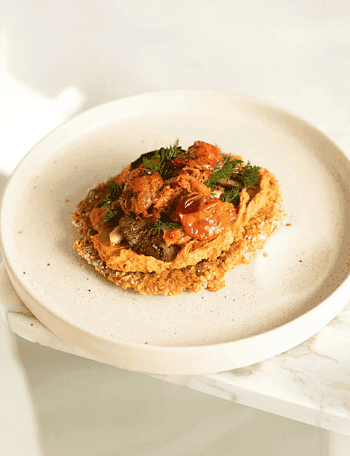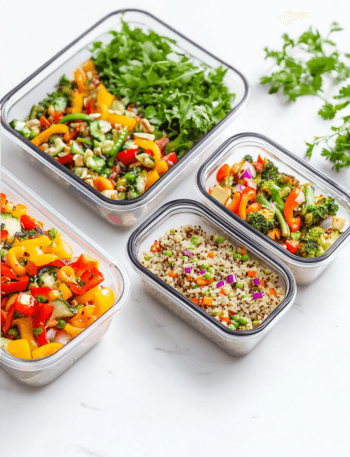Baking can be a delightful experience, but navigating dietary restrictions like gluten-free and vegan can sometimes feel overwhelming. Fear not, fellow bakers! This comprehensive guide will equip you with the knowledge and confidence to make successful substitutions in your favorite recipes, ensuring delicious results every time. Whether you’re a seasoned baker or just starting your gluten-free vegan journey, this guide will become your go-to resource.
While this post covers the basics, for a comprehensive, searchable guide with nearly 80 specific ingredient swaps, including measurement tips and brand ideas, be sure to check out our interactive Gluten-Free & Vegan Substitutions Guide!
FTC Disclosure: This website is supported by advertising and affiliate marketing. This means that when you click on links to various merchants on this site and make a purchase, I can make a commission. As an Amazon Associate, I earn from qualifying purchases. I also participate in other affiliate programs and may earn from qualifying purchases or advertisements. These commissions help me maintain this website and provide you with free content. Rest assured that I only recommend products or services that I personally use or believe are of high quality.
(Gluten-Free Flours)
- 1:1 Gluten-Free Baking Flour: This is your best friend! Designed to replace wheat flour in a 1:1 ratio, it often contains xanthan gum or another binding agent. Ideal for cakes, cookies, muffins, and most recipes that call for all-purpose flour.
- Almond Flour: Made from ground almonds, it adds a nutty flavor and slightly denser texture. Best for cookies, cakes, and some bread recipes. Use in combination with other flours for best results.
- Oat Flour: Ground from rolled oats, it adds a slightly sweet and nutty flavor. Great for cookies, pancakes, and some bread recipes. Use in combination with other flours.
- Brown Rice Flour: A common gluten-free flour, it can be used in combination with other flours for a balanced texture.
- Tapioca Starch/Flour: Adds a chewy texture and can be used as a thickener. Often used in combination with other gluten-free flours.
(Vegan Egg Replacers)
- Flax Egg: Mix 1 tablespoon of ground flaxseed meal with 3 tablespoons of water. Let it sit for 5 minutes to thicken. Great for binding and adding moisture.
- Applesauce: Unsweetened applesauce adds moisture and can act as a binder. Best for cakes and muffins.
- Mashed Banana: Adds sweetness and moisture. Ideal for banana bread and similar recipes.
- Aquafaba: The liquid from canned chickpeas! It can be whipped into meringues and used as an egg replacer in some recipes.
- Commercial Egg Replacer: A blend of starches and gums specifically designed to replace eggs in baking. Follow package directions.
(Vegan Dairy Substitutes)
- Plant-Based Milk: Almond milk, soy milk, oat milk, coconut milk – the options are endless! Choose unsweetened varieties for baking.
- Vegan Butter: Available in stick or tub form, it replaces butter in a 1:1 ratio. Make sure it’s softened for best results.
- Coconut Oil: Can be used in place of butter or other oils. Melts at lower temperatures.
- Vegan Cream Cheese: Replaces cream cheese in frostings and cheesecakes.
(Sweeteners)
- Maple Syrup: A natural liquid sweetener. Adds a distinct flavor.
- Agave Nectar: Another liquid sweetener, slightly sweeter than sugar.
- Coconut Sugar: A less refined sugar with a caramel-like flavor.
- Dates (Medjool): Can be blended into a paste for a natural sweetener.
(Tips for Successful Substitutions)
- Read the recipe carefully: Pay attention to the role each ingredient plays.
- Start with trusted recipes: Look for gluten-free vegan recipes that have been tested and reviewed.
- Don’t be afraid to experiment: Baking is a science, but it’s also an art!
- Keep notes: Record your substitutions and how they affect the outcome.
With this guide, you’re well on your way to becoming a
gluten-free vegan baking pro! Remember that practice makes perfect. Don’t be
discouraged if your first attempt isn’t perfect. Keep experimenting and have
fun!
What are your favorite gluten-free vegan baking substitutions? Share your tips and tricks in the comments below!
Frequently asked questions:
1. What is the difference between 1:1 gluten-free baking flour and other gluten-free flours? 1:1 gluten-free baking flour is specifically formulated to mimic the behavior of wheat flour in baking recipes. It contains a blend of gluten-free flours and a binding agent (like xanthan gum) in the correct proportions, so you can substitute it for wheat flour in a 1:1 ratio. Other gluten-free flours (like almond flour or oat flour) don’t have this balanced composition and require different ratios and often additional binding agents.
2. Do I need xanthan gum if my gluten-free flour blend already contains it? No, if your 1:1 gluten-free baking flour blend already includes xanthan gum (or another binding agent), you don’t need to add more. Adding extra xanthan gum can sometimes result in a gummy or dense texture.
3. Can I use regular all-purpose flour in these recipes? No, this guide is specifically for gluten-free and vegan baking. Regular all-purpose flour contains gluten, which is not suitable for those with celiac disease or gluten sensitivity.
4. What if I don’t have all the recommended gluten-free flours? It’s best to stick to the recommended flour blends for each specific recipe, as different flours have different properties. However, in a pinch, you can try substituting similar flours (e.g., brown rice flour for another gluten-free flour blend) but be prepared for potential changes in texture and outcome.
5. Can I use the same egg replacer for all recipes? While flax eggs and commercial egg replacers are versatile, some recipes may benefit from specific replacers. Applesauce, for instance, works well in cakes and muffins, while aquafaba is better suited for recipes that require whipping (like meringues). Pay attention to the recipe instructions and recommendations.
6. Can I substitute regular dairy milk or butter for the vegan versions? No, this guide focuses on vegan substitutions. Dairy milk and butter are not vegan.
7. What are the best plant-based milk options for baking? Unsweetened almond milk, soy milk, and oat milk are all good choices for baking. Avoid flavored or sweetened varieties, as they can alter the sweetness and flavor profile of your recipe.
8. How do I know which sweetener to use? The type of sweetener can impact the taste and texture of your baked goods. Maple syrup and agave add moisture, while coconut sugar adds a caramel-like flavor. Experiment to find what works best for you.
9. What are some common problems with gluten-free vegan baking and how do I fix them? Common issues include dry or crumbly textures (often due to lack of moisture or binding agents) or dense, gummy textures (from overmixing or too much binding agent). Make sure to measure ingredients accurately, use the recommended flours and replacers, and avoid overmixing.
10. Where can I find reliable gluten-free vegan recipes? Many online resources and cookbooks specialize in gluten-free and vegan baking. Look for recipes from trusted sources that have been tested and reviewed. Don’t be afraid to experiment and adapt recipes to your liking!




You actually make it appear really easy together with your presentation but I in finding this topic to be really one thing that I believe I might never understand. It kind of feels too complicated and extremely large for me. I’m having a look forward for your next put up, I will attempt to get the cling of it!